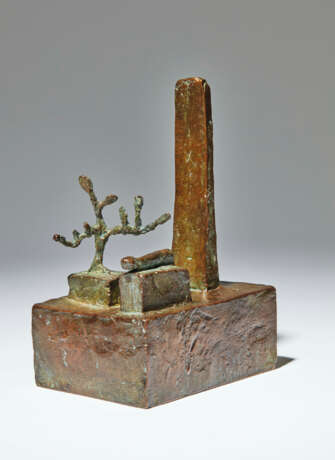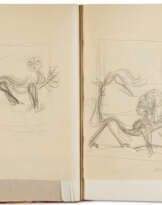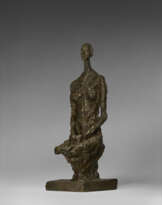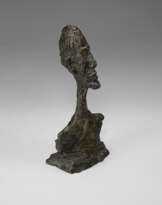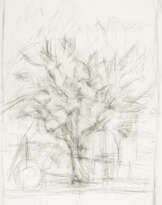ID 930230
Los 118 | Alberto Giacometti (1901-1966)
Schätzwert
€ 200 000 – 300 000
Projet pour une place
signé 'A. Giacometti' (sur le coté gauche de la base); numéroté et avec le cachet du fondeur '5/8 CIRE C. VALSUANI PERDUE' (au dos de la base)
bronze à patine brun vert
18.4 x 9.2 x 12.9 cm.
Conçu en 1946; cette épreuve fondue vers 1993-94
signed 'A. Giacometti' (on the left side of the base); numbered and stamped with the foundry mark '5/8 CIRE C. VALSUANI PERDUE' (on the back of the base)
bronze with brown and green patina
7 1/4 x 3 5/8 x 5 1/8 in.
Conceived in 1946; this bronze cast circa 1993-94
Provenance
Collection particulière, Luxembourg (en 1994).
Literature
Base de données de la Fondation Alberto et Annette Giacometti, no. AGD 3900.
Special notice
Artist's Resale Right ("droit de Suite").
If the Artist's Resale Right Regulations 2006 apply to this lot, the buyer also agrees to pay us an amount equal to the resale royalty provided for in those Regulations, and we undertake to the buyer to pay such amount to the artist's collection agent.
Post lot text
L'année 1946 marque le point d’orgue du style caractéristique du travail d’Alberto Giacometti. Emporté dans une période de créativité et de destruction frénétique pendant la décennie précédente, l’artiste abandonne le travail d’après la réalité au profit de la mémoire; il commence à créer des sculptures de scènes et de personnages comme il s’en rappelle, à travers la lentille déformante et l'interprétation de son imaginaire. « À ma grande horreur, les sculptures sont devenues de plus en plus petites. Elles n’étaient fidèles à la réalité que lorsqu’elles étaient petites… Quand je suis assis à l’extérieur d’un café et que je vois les gens passer sur le trottoir de l’autre côté de la rue, je les vois comme des figurines minuscules, et je trouve cela merveilleux » (Giacometti, cité dans M. Matter, Alberto Giacometti, Paris, 1987, p. 205).À partir de ce moment, le sculpteur a commencé à rétrécir et allonger ses personnages, surmontant leurs bustes de têtes d’épingle et étirant leurs membres, comme s’ils étaient faits d’élastiques. « Plus je construis, plus je comprime » à écrit Giacometti en 1946 (ibid, p.206).La compression, la figuration, et l’espace négatif vont de pair avec les concepts de permanence et de mémoire, comme ici, avec ce Projet pour une place. La nature sombre des sculptures aux proportions déformées trouve ses racines dans la philosophie existentialiste - comme Louis Aragon et Albert Camus, Giacometti s’intéressait à la crise identitaire et à la transition vers des modes de pensée existentialistes stimulés par deux guerres mondiales. Projet pour une place fait référence à la dévastation provoquée par la guerre au début du XXème siècle. Dans cette oeuvre, nous sommes confrontés à « un projet de monument commémoratif qui représente symboliquement la vie et la mort sous la forme d’un arbre qui est à la fois vivant et abattu » (C. di Crescenzo, Alberto Giacometti, Sculture, dipinti, disegni, Florence, 1995, p. 57.).Dans Projet pour une place, un arbre tordu, une pierre tombale imposante et un bloc allongé - l’arbre abattu émerge de manière inquiétante, presque fantasmagorique, du socle en bronze - repésentent la fascination de l’artiste pour les questions d’échelle, et pour ses manipulations, questions que l'artiste traitera de manière récurrentedurant cette période de transition du milieu des années 1940.
Conçu pour orner une place, la présente oeuvre fonctionne également comme une vitrine pour l'artiste, mettant en avant l'évolution de symboles clefs de son travail. Ces motifs emblématiques forment la pierre angulaire de la vision artistique et intellectuelle de Giacometti en cette année décisive de 1946.
1946 marks the crystallization of Alberto Giacometti’s trademark style. Having engaged in a period of frenzied creation and destruction the decade prior, in 1940 the artist abandoned working from life in favour of memory; he began to create sculptures of scenes and sitters as he remembered them, through the distorting lens of imaginative interpretation. ‘To my horror the sculptures became smaller and smaller. They were only true to life when small … When I am outside at a café and I see people passing on the sidewalk across the street, I see them as very small, as tiny figurines, which I find marvellous’ (Giacometti, quoted in M. Matter, Alberto Giacometti, Paris, 1987, p. 205).
From this moment onwards, the sculptor began to shrink and elongate his figures, reducing heads to pinpricks, stretching out limbs as though they were made from elastic. ‘I find the more I construct the more I compress’ wrote Giacometti in 1946 (ibid, p. 206). Compression, figuration, and negative space sit alongside concepts of permanence and memory in the present sculptures, Projet pour une place.
The sombre nature of Giacometti’s proportionally-skewed sculptures finds its roots in Existentialist philosophy – like Louis Aragon and Albert Camus, Giacometti was interested in the crisis of identity and the transition towards Existential ways of thinking stimulated by two World Wars. Projet pour une place alludes to the devastation engendered by war in the early twentieth century. In this work we are faced with ‘the project for a commemorative monument that symbolically represents life and death in the form of a tree that is living and chopped down’ (C. di Crescenzo, Alberto Giacometti, Sculture, dipinti, disegni, Florence, 1995, p. 57.). In Projet pour une place, a twisted tree, a towering gravestone, and an elongated block – the chopped tree – emerge hauntingly, almost phantasmically, from a bronze base.
The present sculpture is a sharp demonstration of the artist’s fascination with, and manipulation of, scale during his transitional period of the mid-1940s. At the same time, together the two works function as a tastemaker for the artist, foregrounding the evolution of key symbols within his oeuvre. These iconic motifs form the cornerstone of Giacometti’s artistic and intellectual vision during the watershed year of 1946.
| Künstler: | Alberto Giacometti (1901 - 1966) |
|---|---|
| Kunst Stil: | Moderne Kunst |
| Künstler: | Alberto Giacometti (1901 - 1966) |
|---|---|
| Kunst Stil: | Moderne Kunst |
| Adresse der Versteigerung |
CHRISTIE'S 9 Avenue Matignon 75008 Paris Frankreich | ||||||||||||||
|---|---|---|---|---|---|---|---|---|---|---|---|---|---|---|---|
| Vorschau |
| ||||||||||||||
| Telefon | +33 (0)1 40 76 85 85 | ||||||||||||||
| Fax | +33 (0)1 40 76 85 86 | ||||||||||||||
| Nutzungsbedingungen | Nutzungsbedingungen | ||||||||||||||
| Versand |
Postdienst Kurierdienst Selbstabholung | ||||||||||||||
| Zahlungsarten |
Banküberweisung | ||||||||||||||
| Geschäftszeiten | Geschäftszeiten
|
